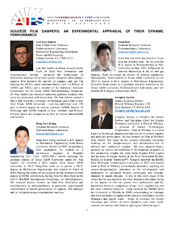| dc.description.abstract | Lecture 15: Squeeze Film Dampers (SFDs) are effective means to ameliorate rotor vibration amplitudes and to suppress instabilities in rotor-bearing systems. A SFD is not an off-the-shelf mechanical element but tailored to a particular rotor-bearing system as its design must satisfy a desired damping ratio; if too low, the damper is ineffective, whereas if damping is too large, it locks the system aggravating the system response. In many cases, SFDs are also employed to control the placement of (rigid body) critical speeds displacing the machine operation into a speed range with effective structural isolation. Industry demands well-engineered SFDs with a low footprint to reduce cost, maintenance, weight, and space while pushing for higher operating shaft speeds to increase power output. Compact aero jet engines implement ultra-short length SFDs (L/D ? 0.2) to satisfy stringent weight and space demands with low parts count. A manufacturer, as part of a business plan to develop and commercialize energy efficient aircraft gas turbine engines, supported a multiple–year project to test novel SFD design spaces. In spite of the myriad of analyses and experimental result reported in the literature, there has not been to date a concerted effort to investigate the dynamic forced performance of a SFD through its many configurations: open ends vis-à-vis sealed ends conditions, and supply conditions with a fluid plenum or deep groove vis-à-vis feed holes directly impinging into the film land. This lecture presents experimental results obtained with a dedicated rig to evaluate short length SFDs operating under large dynamic loads (2.2 kN ? 500 lbf) that produced circular and elliptical whirl orbits of varying amplitude, centered and off-centered. The lecture first reviews how SFDs work, placing emphasis on certain effects largely overlooked by practitioners who often regard the SFD as a simple non-rotating journal bearing. These effects are namely fluid inertia amplification in the supply or discharge grooves, pervasive air ingestion at high whirl frequencies, and effective end sealing means to enhance damping. The bulk of the lecture presents for various SFD configurations comparisons of experimentally identified damping (C) and inertia or added mass (M) coefficients versus amplitude of motion (orbit size) and static eccentricity position, both ranging from small to large; as large as the film clearance! The experiments, conducted over six plus years of continued work give an answer to the following fundamental practitioners’ questions: (a) Dampers don’t have a stiffness (static centering capability), how come? (b) Why is there fluid inertia or added mass in a damper? Isn’t a damper a purely viscous element? (c) How much do the damping and added mass change when the film length is halved? What about increasing the clearance to twice its original magnitude? (d) How much more damping is available if the damper has end seals? (e) Is a damper with feed holes as effective as one containing a groove that ensures lubricant pools to fill the film? What if a hole plugs, is a damper still effective? (f) Do the amplitude and shape of whirl motion affect the damper force coefficients? (g) What happens if the damper operates largely off-centered; does its performance become nonlinear? (h) What do prevailing theoretical predictions correlate with the experimental record? | en |


